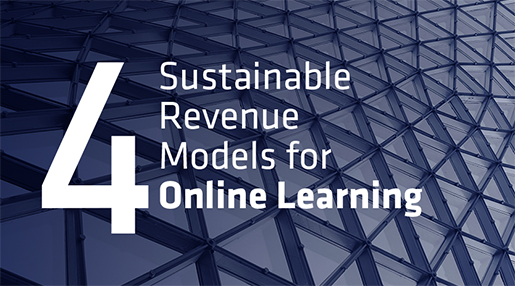For many online learning in higher education means either the use of online video-based for-credit classes or massive open online courses (MOOCs). While the research completed by ExtensionEngine (EE) confirmed that these are indeed the most common …approaches, the company also found two other significant opportunities for earning sustainable revenue from online learning: pre-matriculation programs and post-graduation programs. In this article I describe what is covered by ExtensionEngine’s white paper and highlight some of the significant research findings.
Models for online learning
While online for-credit classes and MOOCs are the most common approaches in higher education, making the commitment to these types of learning experiences requires a strong organizational commitment from the college or university. In the first case, for-credit classes are highly valued by faculty. Any new technology or delivery method can face lots of hurdles before it can be integrated into the curriculum. In the second case, a MOOC has, almost by definition, a huge public audience. This makes it extremely important to the institution, thereby requiring a significant investment of time, money, and the school’s best faculty. Both of these situations necessarily slow down the usage of online technology.
Given the above and the power and attraction of online learning, EE set out to determine how this tool is being used among 136 top U.S. colleges and universities. It examined the web pages of the top 100 U.S. colleges and universities by enrollment and the top 50 national universities according to US News and World Report (with some overlap between the two lists). The company published a white paper that details the relative popularity of different types of programs against college type (private or public), enrollment, and endowment size:
- For credit
- 71% of these institutions offer courses that are part of some degree program.
- Research
- 58% of these institutions have provided courses whose purpose seems to be to provide a way for both the institution and involved faculty to learn about the experience of online learning while also providing high quality exposure for the institution.
- Pre-matriculation
- 10% of institutions provide online courses targeted at prospective or incoming students.
- Post-graduation
- 19% of these institutions have offered online programs as a means to connect with alumni.
The white paper goes into great detail about these different models of online learning that are used in higher education, the pros and cons of each, the revenue potential of each, and the reasons why an institution might find a particular approach attractive. A close reading of the introductory section of this white paper would be useful to anyone looking for different ways he/she might introduce online learning into his/her college or university.
Opportunities For Differentiation
Given the averages reported in the list above, it is clear that significant revenue opportunities are available for institutions that, not coincidentally, also serve the needs and interests of many students and alumni. In this article I focus on the two models described in this white paper for applying online learning that are less frequently used by higher education institutions:
- Online pre-matriculation courses are currently being used by some institutions to attract, enroll, assess, and prepare prospective students before they arrive on campus.
- Online post-graduation courses are being used both to improve, extend, and deepen alumni engagement and to beef up the continuing education offerings, both required and elective, that the institution might already have in place.
Much information is hidden if you simply focus on the averages reported above. Fortunately, EE reported some segmented results as well. Let us consider some of these segments for the two models for online learning that are less commonly implemented.
For the pre-matriculation programs at these institutions, 81% offer in-person programs but only 10% offer online programming for this purpose. While both public and private institutions were equally likely to offer in-person programs, EE found that private institutions are about 3x more likely to offer online pre-matriculation programs. Also, schools with larger endowments generally offered both online and in-person pre-matriculation programs at higher rates than those institutions with smaller endowments.
For post-graduation programs at these institutions, about 60% of institutions offer in-person programs but just less than 20% offer alumni online programs specifically designed for them. The differences in public and private post-graduate offerings are flipped from the pre-matriculation differences above. The rate of online offerings is quite similar (17% vs. 21%) while the rate of in-person programs are quite different (46% vs. 77%). In either case most institutions still have an opportunity to take advantage of the benefits of online learning. When looking at the data sliced by endowment size, institutions with larger endowments are more likely both to offer in-person programs (with a quite strong relationship) and online programs (with a weaker relationship).
Conclusion
EE gathered data from large and/or highly reputable U.S. institutions, determining to what extent they are using online learning, and which models for online learning that they are using. Both the for-credit and research models are commonly used by these institutions. On the other hand, they have been less likely to use either pre-matriculation or post-graduation models. Here is a significant take-away from this white paper:
Given (1) the importance of online learning in higher education with its ability to reach a diverse and dispersed audience combined with both (2) the difficulty and/or expense of using the for-credit and research models and (3) the relative scarcity of the pre-matriculation and post-graduation models, higher education institutions have an opportunity to differentiate themselves while simultaneously attracting a wider base of qualified applicants and providing a valuable service to alumni who might, therefore, be more likely to engage with their alma mater.
This finding should be exciting for any supporter of online learning who is looking for more opportunities to get people engaged with his/her institution. Read the white paper A Framework for Online Learning Revenue Models at Universities: Research and Opportunities to get more details on all of the above.
Note
This article was originally published on July 16, 2015 by eLearning Industry at this location.


